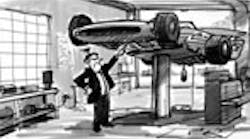Pipe dreams
Problem 187 — Proper ID can be required in some unlikely places, as this month’s problem by Tom Lee of Brooklyn, N.Y., demonstrates.
It was long past midnight about a week before the annual Tooterville Grand Slam 500 auto race, and in the garage of favored champion, Buford DePouff, a heated argument was taking place.
“This type of hollow driveshaft you’re proposing won’t work,” stormed Roland Skimmp, the mechanic. “This has gone too far! Why, the solid shaft is dimensioned to take 2.5 times the maximum engine torque. You’re mad!”
“It’ll certainly work!” countered De- Pouff. “How do think I’ve won all the other races? We make the car as light as possible. Why, I’ve used plastic and aluminum throughout, even in the gearing. I’ve cut donut holes in the frame, and I’ve used the thinnest door panel metal I can find.”
“THE SHAFT WILL SNAP!” shouted Skimmp, as he slammed his cap on the floor and stomped out.
The hollow driveshaft was 60 in. long. It had an OD of 4 in., ID of 2 in. and was made with a steel having a density of 0.284 lb/in.3 DePouff maintained that it would carry 15/16 of the torque normally carried by a solid shaft of the same steel and proportions.
Who is right? Can the hollow shaft handle 15/16 of the torque that a solid shaft can handle? Neglect the change in natural frequency and possible vibration problems. For extra credit, how much weight was saved by using a hollow shaft?
Technical consultant, Jack Couillard, Menasha, Wis.
Solution to last month’s problem 186 — You’re not likely to go off on a tangent if you answered, 215.6 ft plus 1:12 p.m. and 2:12 p.m. for the times of day when the readings were taken. Here’s the angle:
Let:
x = Height of pillar, ft
Φ = Angle between the tip of 140-ft shadow and level ground, deg
Since the sun travels 180 deg in 12 hr, we know that it travels 15 deg per hr. Hence, the angle between the tip of the 70-ft shadow and the ground is Φ + 15 deg.
We can set up the following equations:
Re-arrange both equations in terms of x and simplify:
Multiply both sides by the denominator and substitute the value of tan 15 deg 50.268 to obtain the quadratic equation:
0.536tan2Φ - tanΦ + 0.268 = 0
Let z = tan Φ and solve using the formula for a quadratic equation.
Φ = 17.98 or 57.00. Since the pillar is taller than the 125-ft hill, Φ is 57.00
Continue on page 2
The pillar is 140(tan 57) = 215 ft. Now for the times when the readings were taken. The remaining angle in the triangle formed by the pillar and the 70-ft shadow is 180 - (90 + 72) deg, or 18 deg. This is also the angle of the sun from the vertical. Since the sun travels 15 deg/hr in this problem, the time of the first reading is 1:12 p.m. and that of the second reading, 2:12 p.m.
Schamm had better recalibrate his theory!
Contest winner — Congratulations to Gregory David Aviza of Boston, who won our July contest by having his name drawn from the 78 contestants who answered correctly out of a total of 79 entrants for that month. A TI-68 calculator is in the mail to him.
The TI-68 Advanced Scientific Calculator by Texas Instruments can solve five simultaneous equations with real and complex coefficients and has 40 number functions that can be used in both the rectangular and polar coordinate systems. Other functions include formula programming, integration, and polynomial root finding. The calculator also features a last-equation replay function that lets you double-check your work.




